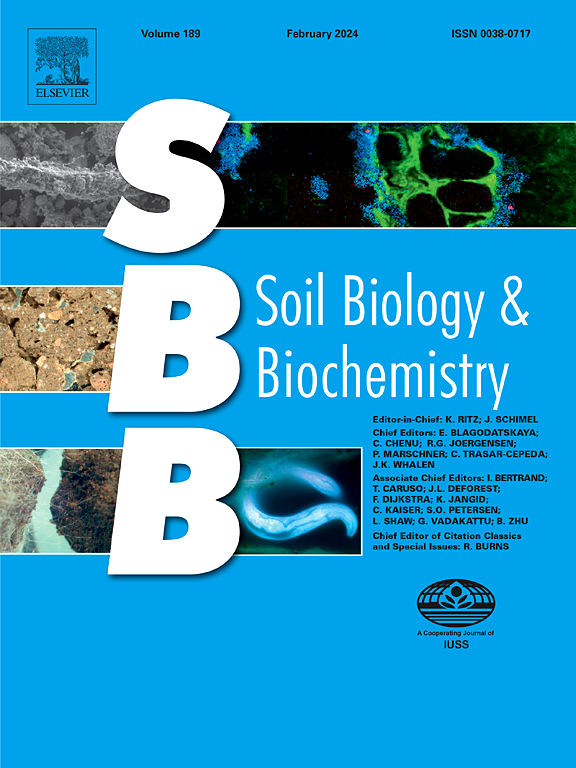城市化和植物入侵对枯木生物群和分解率的影响取决于树种
IF 9.8
1区 农林科学
Q1 SOIL SCIENCE
引用次数: 0
摘要
人类活动正在迅速重塑生态系统,城市化和植物入侵的同时出现已成为危及全球生物多样性和生态系统功能的重大挑战。枯木是生物多样性和碳储存的重要提供者,但城市化和植物入侵如何单独或交互影响栖息在木材中的类群和分解率仍是未知数。在这里,我们在加拿大多伦多城市化梯度沿线的 19 个受入侵和未受入侵的配对地块上,使用槭树和松树进行了为期两年的木材分解实验。我们评估了城市化和长春花入侵对细菌、真菌和昆虫群落组成和多样性以及木材分解率的单独影响和综合影响,这些影响部分是由这些类群驱动的。我们的研究结果表明,城市化对所有三个类群的多样性以及细菌和真菌群落的组成都有单独的影响。植物入侵单独影响了真菌和昆虫的多样性。城市化和植物入侵的交互影响只出现在松柏的真菌多样性上。不同树种的木材分解率各不相同,城市化加快了刺松的分解率,但没有加快糖槭的分解率。真菌是唯一对木材分解有显著影响的类群。我们的研究结果共同表明,城市化和植物入侵会导致枯木栖息群落和分解过程发生变化,但它们之间的交互影响并不重要。研究还表明,这些影响在树种之间存在差异。因此,综合考虑各种人为因素和不同树种的综合影响,对于制定有效的策略来恢复和维持城市景观中的生物多样性和生态系统功能至关重要。本文章由计算机程序翻译,如有差异,请以英文原文为准。
Tree species-dependent effects of urbanization and plant invasion on deadwood biota and decomposition rates
Human activities are swiftly reshaping ecosystems, and the simultaneous rise of urbanization and plant invasions has become a significant challenge that jeopardizes both global biodiversity and ecosystem function. Deadwood is an important provider of biodiversity and carbon storage, yet it remains unknown how urbanization and plant invasion affect wood-inhabiting taxa and decomposition rates, separately and interactively. Here we conducted a two-year wood decomposition experiment using Acer saccharum and Pinus strobus at 19 paired invaded and uninvaded plots along an urbanization gradient in Toronto, Canada. We assessed the individual and combined effects of urbanization and plant invasion by Vincetoxicum rossicum on the community composition and diversity of bacteria, fungi and insects, as well as on wood decomposition rates, which are partly driven by these taxa. Our results show that urbanization had individual effects on the diversity of all three taxa and on the composition of bacterial and fungal communities. Plant invasion individually affected fungal and insect diversity. Interactive effects of urbanization and plant invasion occurred only for fungal diversity in Pinus strobus. Wood decomposition rates varied by tree species, with urbanization accelerating the rates for Pinus strobus but not Acer saccharum. Fungi were the only taxon that significantly influenced wood decomposition. Our findings together indicate that urbanization and plant invasion lead to changes in deadwood-inhabiting communities and decomposition processes, yet their interactive effects are of minor importance. They also show that these effects differ between tree species. Hence, integrating the combined effects of various anthropogenic drivers and different tree species is crucial for developing effective strategies to restore and sustain biodiversity and ecosystem functioning in urban landscapes.
求助全文
通过发布文献求助,成功后即可免费获取论文全文。
去求助
来源期刊

Soil Biology & Biochemistry
农林科学-土壤科学
CiteScore
16.90
自引率
9.30%
发文量
312
审稿时长
49 days
期刊介绍:
Soil Biology & Biochemistry publishes original research articles of international significance focusing on biological processes in soil and their applications to soil and environmental quality. Major topics include the ecology and biochemical processes of soil organisms, their effects on the environment, and interactions with plants. The journal also welcomes state-of-the-art reviews and discussions on contemporary research in soil biology and biochemistry.
 求助内容:
求助内容: 应助结果提醒方式:
应助结果提醒方式:


